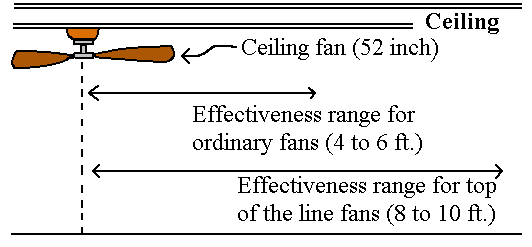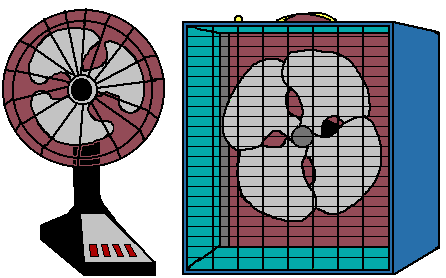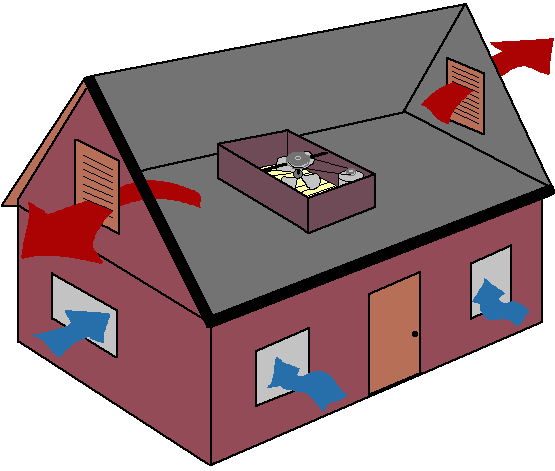BE A FAN OF GOOD VENTILATION
- GOAL:
- The student will understand that the use of a ceiling fan, as well as other types of fans, can reduce cooling needs, and thus cooling costs in the home.
- OBJECTIVES:
- The student will be able to:
- 1. Explain how proper ventilation reduces the need for air conditioning.
- 2. Describe the correct way to select and operate a ceiling fan.
- 3. List other types of fans that improve ventilation.
- LESSON/INFORMATION:
- Natural ventilation, the flow of air through a building, is sometimes not sufficient to keep the occupants of the building cool and comfortable. In the Louisiana summer, most people turn to air conditioning to increase the flow of cool air in the home. Central air conditioning units, however, use a lot of energy and are expensive to operate. Fans, particularly ceiling fans, are a good option to increase air circulation while saving energy.

- ACTIVITY 1:
- An ordinary lamp with a 60 watt incandescent bulb uses 60 watts of electricity an hour. In comparison, how much electricity do you think a 48" ceiling fan operating at medium speed uses in an hour? Less? More? A lot more?
- ____________________________________________________________
- _____________________________________________________________
- The fan described above uses only about 40 watts of electricity an hour. This can help to keep one cool -- and keep cooling costs under control.
- Ceiling fans can be used in two ways to help reduce cooling costs:
- 1. Use the ceiling fans instead of the air conditioner.
- 2. Use the ceiling fans along with the air conditioner, but raise the thermostat 2°F to 6°F. Each degree the thermostat is raised can save 4% to 8% on cooling costs.
- Using fans rather than the air conditioner will produce the most savings, up to 80% off cooling costs. Some people, however, may not feel comfortable in the summer months using only the fans.
- Using the fans along with the air conditioner increases air circulation and makes people feel cooler at a higher temperature. By using the fans, the thermostat can be raised without losing comfort and a 15% to 30% savings on cooling costs is possible. Ceiling fans cool people, not rooms. When leaving a room, turn fan off.
- ACTIVITY 2:
- Complete the following calculations about the cooling costs for three families. You are given the amount spent on cooling costs when the thermostat is set at 72°F. Compare the energy savings if the families use ceiling fans and raise the thermostats by 6°F. (Assume an 8% savings per degree.)
- Example:
- The thermostat was raised from 72°F to 78°F. Last month, $55 was spent on cooling costs. How much could have been saved by raising the thermostat? What would the cost be?
- Degrees Raised x 8% Savings = Total % Savings
- 6° x 8% = 48%
- Savings at 78°F
- .48 (48%) x $55 = $26.40
- Cost at 78°F
- $55 - $26.40 = $28.60
| Cost at 72°F |
|
$ Saved at 78°F |
|
Cost at 78°F |
| $48 |
______________ |
______________ |
| $100 |
______________ |
______________ |
| $125 |
______________ |
______________ |
- When choosing a ceiling fan, it is important to remember:
- 1. Small fans circulate air 4 to 6 feet from their centers; larger fans circulate air 8 to 10 feet from their centers.

| Table 2. Ceiling fan sizing chart |
Largest Dimension
of Room |
|
Minimum
Fan Diameter (in.) |
| 12 ft. or less |
36" |
| 12 - 16 ft. |
48" |
| 16 - 17.5 ft. |
52" |
| 17.5 - 18.5 ft. |
56" |
| 18.5 ft. or more |
2 fans |
- 2. Fit the size of the fan to the size of the room. Use the chart above to help in making this decision.
- 3. For a ceiling fan to work most efficiently, the fan blades should be about 8 to 10 inches from the ceiling and 7 feet above the floor. This allows for adequate air circulation.
- 4. Some ceiling fans are reversible and can be set to blow upwards in the winter in order to send warm air downward. This action is not recommended in rooms with standard 8 foot ceilings but for rooms with high or vaulted ceilings.
- 5. Buy a fan with five blades instead of four.
- Additional factors to consider when buying a ceiling fan include the material from which it is made, the number of speed options, the noise it produces, the installation difficulty, and the warranty provided. Most ceiling fans cost between $50 and $200, and many can be installed by the homeowner.
- In addition to ceiling fans, oscillating fans or box fans can also be used to help circulate air in the home. Oscillating fans rotate from side to side and cool a wide area. Box fans do not rotate, but they can be placed wherever air circulation is needed. Box fans are not as energy efficient as ceiling or oscillating fans.

- Another type of fan is the whole house fan which may be used in place of an air conditioner.This fan type can save up to 60% of cooling costs.

- The whole house fan is placed in the attic where it draws hot, stale air upward. This causes fresh air to be drawn in through the windows of the house, and this breeze makes the indoor temperature seem cooler. This is an energy efficient cooling option, but the whole house fan may not be powerful enough when the temperature exceeds 85°F or when the humidity exceeds 75%.
- Also as the windows of the house must be open at least part of the time, there may be a problem with humidity, dust, and pollen control.
- Any type of fan used in the home will increase air circulation. Circulated air helps people feel cooler at higher temperatures and requires less work from the air conditioning unit. Since fans use less energy than air conditioning units, it is well worth investing in some type of fan to help cool the home.
- RECOMMENDED READING:
- Fans and Ventilation, U.S. Department of Energy, FS 228. March 1989.
- INFORMATION CHECK
- Match the four fan types given with their characteristics below. You will use each fan type more than once. Note: The answer to some questions is "E" -- all of the fan types above. Think -- and use this choice when the statement refers to fans in general.
- A. Box Fan
- B. Ceiling Fan
- C. Oscillating Fan
- D. Whole House Fan
- E. All of the above
- _____1. This fan helps improve upon natural ventilation; it helps increase air flow through the building.
- _____2. Using this fan for one hour on medium speed uses about 40 watts of electricity.
- _____3. This fan cools a wide area as it can be placed where it is needed and it moves from side to side.
- _____4. Of the first three fans listed above, this one uses the most energy.
- _____5. According to the information given, using this fan could allow you to raise the air conditioner thermostat 6°F and save up to 48% on cooling costs.
- _____6. This fan is placed in the attic floor and draws hot air upward.
- _____7. This fan requires that windows be open for it to run properly.
- _____8. This fan increases the breeze or air flow in a home thus allowing people to feel cooler at higher temperatures.
- _____9. This type of fan uses less energy than a central air conditioning unit.
- _____10. These fans usually cost between $50 and $200 and many times can be installed by the homeowner.
- _____11. This type of fan should be placed at least 7 feet from the floor and 8 inches from the ceiling to be most efficient. This is in homes with the standard 8 foot ceilings.
- _____12. Some models of this type fan are reversible and may be used in cold weather in rooms with high ceilings to force warm air downward.
- TEACHER'S NOTES
- ACTIVITY 1:
- The ceiling fan described uses less energy than a 60 watt bulb. It uses only about 40 watts of electricity per hour. The text explains this further.
- ACTIVITY 2:
| Cost at 72°F |
|
$ Saved at 78°F |
|
Cost at 78°F |
| $48 |
$23.04 |
$24.96 |
| $100 |
$48.00 |
$52.00 |
| $125 |
$60.00 |
$65.00 |
- NOTES:
- 1. Central air conditioning -
- While this is an excellent way to keep air cool and circulating, it uses a lot of energy and is very expensive. Many people are looking to fans to help cut down on cooling expense.
- 2. Fans and air conditioning -
- Many people have found that by using fans they can raise the thermostat on the air conditioning unit. This allows some savings on cooling costs without reducing comfort.
- 3. Whole house fans -
- These fans work on the concept that if hot air is pulled upwards into the attic and pushed outward by attic vents, this pressure will cause cooler, fresher air to be pulled in by lower windows.
- DEFINITIONS:
- Ventilation -
- The flow of air through a building. This is desired to keep air from becoming stagnant and, in summer, to keep cool air circulating.
- ANSWERS TO INFORMATION CHECK:
- 1. E
- 2. B
- 3. C
- 4. A
- 5. B
- 6. D
- 7. D
- 8. E
- 9. E
- 10. B
- 11. B
- 12. B
Comments or questions to: TechAsmt@LA.GOV
Return to Home Energy Menu




